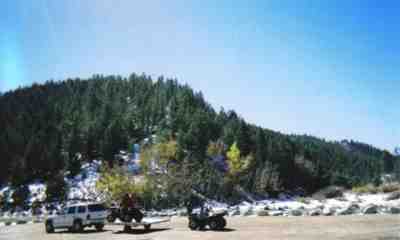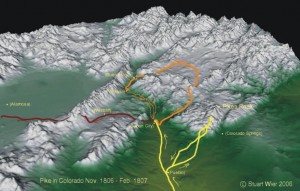Brief by Central Staff
Geography – March 2007 – Colorado Central Magazine
There’s a proposal afoot to christen a heretofore nameless peak in Sagauche County; the suggested name is Mt. Kiamia. A more informative way to spell it would be Mt. KIA/MIA, as the idea is to honor American soldiers who were either Killed In Action or Missing In Action.
The man behind the proposal is Bruce Salisbury, who started with the idea of renaming one of Colorado’s 30-plus Sheep Mountains — in particular, one near Telluride. That peak was in a wilderness area, and the U.S. Board on Geographic Names generally opposes new names inside wilderness areas. The request was denied.

But there are plenty of nameless mountains in Saguache County. This one sits near the ghost town of Shirley — the U.S. Forest Service has a parking area there, complete with restrooms.
You get there by going up the Marshall Pass road for a few miles to a junction with the Silver Creek road. In the summer, it’s an easy drive for a passenger car, but this time of year, a four-wheel-drive vehicle is advisable. It’s not far from Headwaters Hill, the site of an earlier local place-naming, at the triple divide for Gunnison, Arkansas, and Closed Basin drainages.
The proposed Mt. Kiamia is not all that high or steep, and it’s close to the road, thus making it quite accessible.
Salisbury reports that he met with the Saguache County Commissioners, “who gave the idea their support,” with the final decision coming from the state and federal boards of geographic names.
The KIA/MIA acronym is meaningful, but there’s also a happy coincidence. Since the hill is in the heart of what was once Ute territory, Salisbury checked with Thomas Givon, the linguist who compiled the first Southern Ute dictionary about 30 years ago — until then, Southern Ute was not a written language.
Givon, now retired from the University of Oregon and living in the Southern Ute reservation headquarters town of Ignacio, has maintained his “interest in Ute language and culture,” as well as his connections with “tribal members who still speak the language.”
Here’s what he had to say:
After consultation with several Ute speakers, I am in the position to determine that indeed the compound name Kiyà-miyà is meaningful in Ute, provided a place-name suffix is added to it, the full name thus reading Kiyà-miyà-vat. The meaning of such a name in Ute is the “place where people walk about playing” or “place where people walk about laughing.” The verb stem kiyà- means “to play” or “to laugh” in the Ute language. The verb stem miyà- means “to walk around” or “to do something while walking about.”
Further, from my — admittedly limited — knowledge of Ute culture, and being myself a veteran, I would say that Kiyà-miyà-vat is a rather appropriate name for a mountain that would honor [among others] Ute veterans. A warrior, once departed, crosses to “the other side,” a place often described as one where a person may walk about in peace, without care, happy; in other words, “a place where people walk about laughing.”
Who’d have ever thought that a pair of modern English acronyms would fit with the ancient language of the Nuche? We hope this little mountain ends up with a pair of names: KIA/MIA and Kiyà-miyà-vat, with a sign at Shirley explaining its meaning and significance.


